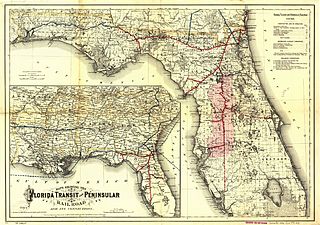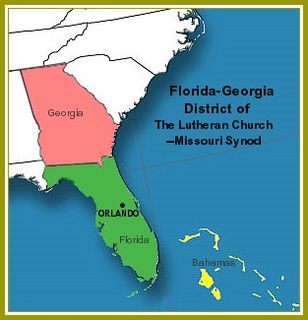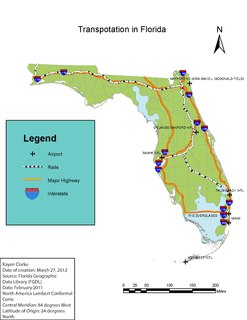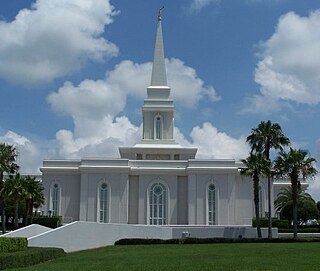
U.S. Route 1 or U.S. Highway 1 (US 1) is a major north–south United States Numbered Highway that serves the East Coast of the United States. It runs 2,369 miles (3,813 km), from Key West, Florida north to Fort Kent, Maine, at the Canadian border, making it the longest north–south road in the United States. US 1 is generally paralleled by Interstate 95 (I-95), though the former is significantly farther west (inland) between Jacksonville, Florida, and Petersburg, Virginia. The highway connects most of the major cities of the East Coast—including Miami, Jacksonville, Richmond, Washington, D.C., Baltimore, Philadelphia, New York City, and Boston passing from the Southeastern United States to New England.
Southeast Airlines was a low fare public charter airline in the United States, headquartered in Largo, Florida, operating regular service to various vacation/leisure destinations using eight McDonnell Douglas DC-9-30 and two McDonnell Douglas MD-80 aircraft. It abruptly ceased operations on November 30, 2004. The airline was featured on The Simple Life reality TV series, which Southeast executives hoped would give the carrier some exposure. The airline's jets featured the "Sun King" logo previously used by the original National Airlines which appeared on the tails of its aircraft.

The State Highway System of the U.S. state of Florida comprises the roads maintained by the Florida Department of Transportation (FDOT) or a toll authority. The components are referred to officially as state roads, abbreviated SR.

Central Florida is a region of the Southern U.S. state of Florida. Different sources give different definitions for the region, but as its name implies it is usually said to comprise the central part of the state, including the Tampa area and the Orlando area. It is one of Florida's three directional regions, along with North Florida and South Florida. It includes the following counties: Brevard, Citrus, Hardee, Hernando, Hillsborough, Indian River, Lake, Manatee, Marion, Orange, Osceola, Pasco, Pinellas, Polk, Seminole, Sumter, and Volusia.

The Florida Central and Peninsular Railroad was the final name of a system of railroads throughout Florida, becoming part of the Seaboard Air Line Railway in 1900. The system, including some of the first railroads in Florida, stretched from Jacksonville west through Tallahassee and south to Tampa. Much of the FC&P network is still in service under the ownership of CSX Transportation.
Interstate 95 (I-95) is the main Interstate Highway of Florida's Atlantic Coast. It begins at a partial interchange with U.S. Highway 1 (US 1) just south of downtown Miami, and heads north past Daytona Beach, through Jacksonville, and to the Georgia state line at the St. Marys River near Becker. The route also passes through the cities of Fort Lauderdale, West Palm Beach, and Titusville.

The Unitarian Universalist Association, an association of Unitarian Universalist Congregations in the United States of America, is composed of 19 Districts.

The Florida-Georgia District is one of the 35 districts of the Lutheran Church–Missouri Synod (LCMS), and encompasses the states of Georgia and Florida, with the exception of the Florida Panhandle which is part of the Southern District; in addition, four Florida congregations and two Georgia congregations are in the non-geographic English District, and four more Florida congregations are in the non-geographic SELC District. The Florida-Georgia District includes approximately 203 congregations and missions, subdivided into 22 circuits, as well as 45 preschools, 35 elementary schools and 2 high schools. Baptized membership in district congregations is approximately 53,800.

The Episcopal Diocese of Central Florida is a diocese in Florida in Province IV of the Episcopal Church. It is bounded on the north by the Episcopal Diocese of Florida, on the east by the Atlantic Ocean, on the south by the dioceses of Southeast Florida and Southwest Florida and on the west by the Gulf of Mexico. The two largest cities in the diocese are Orlando, with over 220,000 people, and Port St. Lucie, with over 150,000 people. The Kennedy Space Center and Walt Disney World are within the boundaries of the diocese. Orlando, where St. Luke's Cathedral is located, is the see city of the diocese.

Transportation in Florida includes a variety of options, including Interstate Highways, United States and Florida State Roads, Amtrak and commuter rail services, airports, public transportation, and ports, in a number of the state's counties and regions.

The Episcopal Diocese of Southwest Florida is a diocese of the Episcopal Church in the United States of America (ECUSA) in Florida which extends from Marco Island on the south, to Brooksville on the north, and inland to Plant City, Arcadia and LaBelle on the east. As part of the ECUSA, the diocese is a constituent member of the worldwide Anglican Communion.

As of December 31, 2017, The Church of Jesus Christ of Latter-day Saints reported 156,961 members in 33 stakes, 260 Congregations, as well as four missions and two temples in Florida.

The Dixie Flagler was a streamlined passenger train operated by the Florida East Coast Railway (FEC) between Chicago, Illinois and Miami, Florida. It began in 1939 as the Henry M. Flagler, a regional service between Miami and Jacksonville, Florida; the FEC renamed it and extended it to Chicago a year later. It was one of the few Chicago to Florida trains that passed through Atlanta. As an overnight streamliner it was part of the every-third-day pool shared by the City of Miami and South Wind. It was renamed Dixieland in 1954 and discontinued altogether in 1957.
The Southland was a night train between Chicago, Illinois and different points in western and eastern Florida in the 1940s and the 1950s. It was distinctive among Midwest to Florida trains as its western branch was the only mid-Twentieth Century long distance train passing from Georgia to Florida bypassing the usual passenger train hub of Jacksonville Union Station. The main operator was the Louisville and Nashville Railroad, and pooling partners were the Pennsylvania Railroad, the Atlantic Coast Line Railroad and to lesser extent, the Wabash Railroad and the Florida East Coast Railway. For southeast bound -but not northwest bound- trips to Norfolk, Virginia, some coaches in 1946 diverged at Cincinnati along a Norfolk and Western Railroad route. Northwest bound, travelers could switch trains at Cincinnati for heading towards Chicago.










